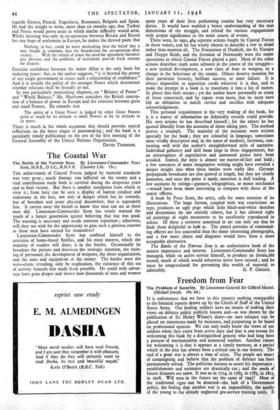The Coastal War
The Battle of the Narrow Seas. By Lieutenant-Commander Peter Scott, M.B.E., D.S.C., R.N.V.R. (Country Life. 15s.)
THE achievement of Coastal Forces judged by material standards was very great ; much damage was inflicted on the enemy and a vital contribution made both to survival during the desperate years and to final victory. But there is another standpoint from which to view it ; from here can be seen a display of human conduct and endeavour in the face, not only of danger which has its rewards, but of boredom and acute physical discomfort, that is supremely fine. It carries away the breath to know that men can act as these men did. Lieutenant-Commander Scott has wisely warned the youth of a future generation against believing that war was good. The warning is necessary and needs constant repetition ; otherwise, will they not wish for the opportunity to gain such a glorious renown as these men have earned for themselves?
Lieutenant-Commander Scott has confined himself to the activities of home-based flotillas, and his main interest, which the majority of readers will share, is in the battles. Occasionally he broadens the picture and discusses the strategic situation, the train- ing of personnel, the development of weapons, the shore organisation, and the aims and equipment of the enemy. The battles were the wave-crests revealing, only by implication, the existence of this sea of activity beneath that made them possible. He could with advan- tage have gone deeper and shown how thousands of men and women
spent years of their lives performing routine but very necessary duties. It would have enabled a better understanding of the true dimensions of the struggle, and related the various engagements with proper significance to the main course of events.
There were, he says, 464 separate actions fought by Coastal Forms in these waters, and he has wisely chosen to describe a few in detail rather than mention all. The Evacuation of Dunkirk, the St. Nazaire and Dieppe Raids, and the Invasion of Normandy were the major operations in which Coastal Forces played a part. Most Of the other actions describec mark some advance in the course of the struggle— a new tactical development, a new class of boat or weapon, or a change in the behaviour of the enemy. Others deserve mention for their particular ferocity, brilliant success, or utter failure. It is always impossible to apportion credit wherever it is due, and to make the attempt in a book is to transform it into a list of names. In places this- fault occurs ; yet the author knew personally so many of those concerned, and by report even more that he must have felt an obligation to match service and sacrifice with adequate acknowledgement.
This personal acquaintance is the very making of the book, for it is a source of information no Admiralty records could provide. His own actions he has described himself ; for the others he has quoted liberally from the accounts of those taking part. The method proves a triumph. The majority of the accounts were written specially for the book ; they are colourful in language, sometimes most vividly descriptive and, in the name of modesty, facetious, con- trasting well with the author's straightforward style of narrative. Individual gallantry and skill loom large in these engagements, but an extravagance of superlatives and unwanted praise have been avoided. Indeed, the style is almost too matter-of-fact and bald ; a few sentences of more imaginative writing might have revealed a deeper insight into • what these battles were really like. German propaganda broadcasts are also quoted at length, but they are clearly nonsense, and once the point is made, nonsense is dull reading. A few accounts by ratings—gunners, telegraphists, or motor mechanics —would have been more interesting to compare with those of the senior officers.
A book by Peter Scott, the artist, calls for some mention of its illustrations. The large format, coupled with war restrictions on type, produces an ugly page which little black-and-white sketches and decorations do not entirely relieve, but it has allowed eight oil paintings of night encounters to be excellently reproduced in colour. Of these a reviewer untrained in art can only say that he finds them delightful to lodk at. The pencil portraits of command- ing officers are less successful than the many interesting photographs, and a few more charts and diagrams would have been a more acceptable alternative.
The Battle of the Narrow Seas is an authoritative book of the utmost importance and interest. Lieutenant-Commander Scott has managed, while on active service himself, to produce an invalu.ble record, much of which would otherwise never have existed ; and he must be congratulated for presenting this wealth of material so






























 Previous page
Previous page